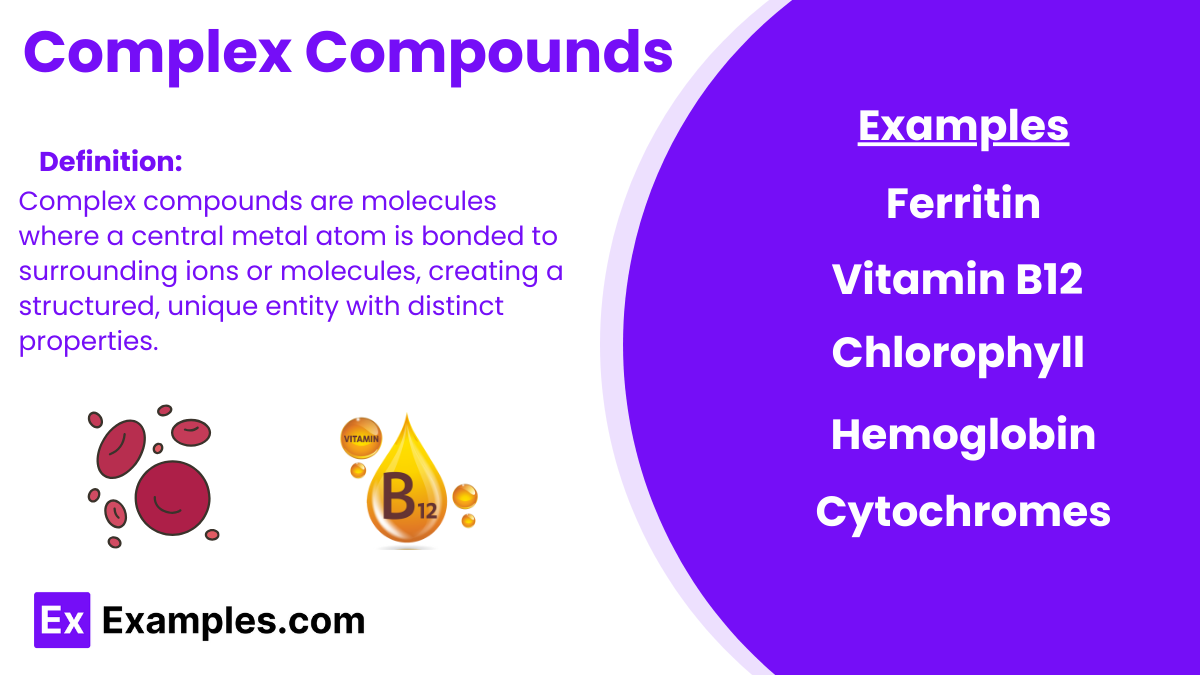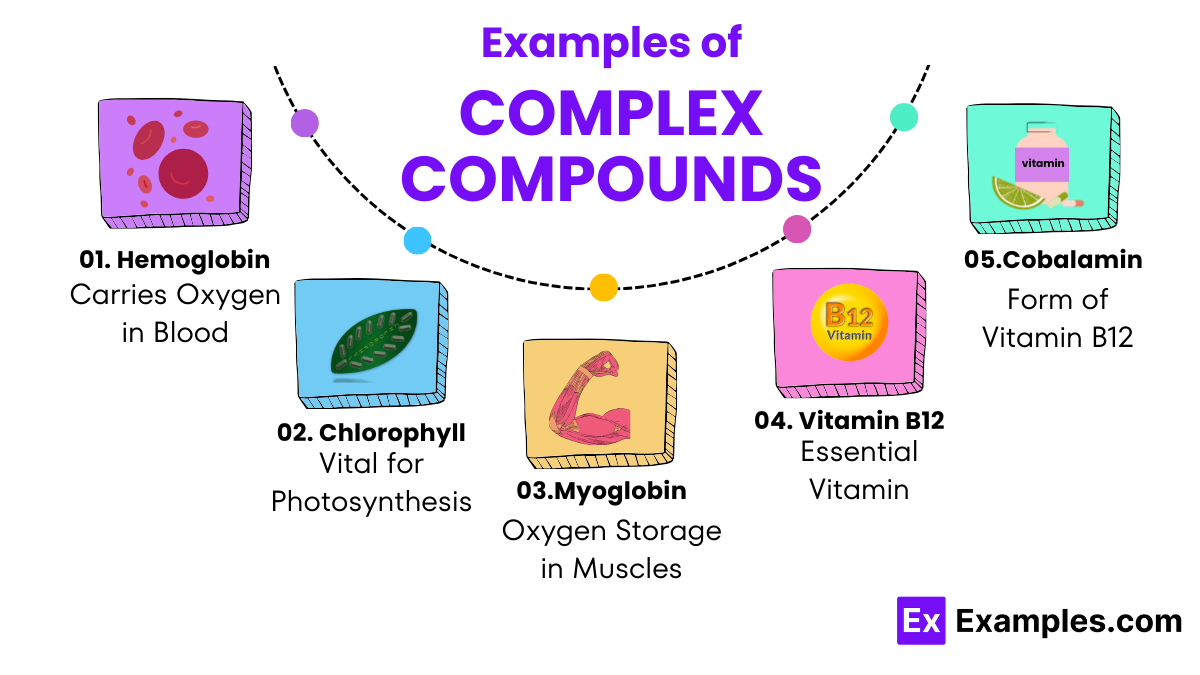What is a complex compound?
A compound consisting of only one type of element
A compound where metals are bonded to ligands
A compound that only exists in gaseous form
A compound that does not contain any metal atoms


Complex compounds, also known as coordination compounds, often fascinating to explore, are chemical structures formed when a central metal atom or ion binds with surrounding molecules or ions called ligands. Imagine the metal at the heart of these compounds as a sun, with ligands orbiting around it like planets. This bond creates a unique, stable entity known for its diverse properties and applications, from vibrant colors in art to crucial roles in biological systems and industrial processes.
Imagine building a model where at the center is a metal piece, and around it, you attach different beads – this is essentially the structure of complex compounds. At the heart of these compounds is a metal atom or ion, kind of like the main character in a story. Surrounding this central character are various other atoms, ions, or molecules, known as ligands, which can be thought of as supporting characters. These ligands are attached to the central metal by bonds, acting like bridges that connect the ligands to the metal. This setup forms a complex, intricate structure, where the metal and its surrounding ligands work together, creating a compound with unique properties. This fascinating architecture not only makes complex compounds essential in many scientific fields but also a captivating topic for anyone keen on understanding the microscopic world of chemistry.

Start by naming the ligands (the atoms, ions, or molecules attached to the central metal atom) in alphabetical order. For negatively charged ligands, use the ending ‘-o’, such as chloro for chlorine. Neutral ligands like water (aqua) and ammonia (ammine) have special names.
Next, name the central metal atom or ion. If the complex ion is an anion (negatively charged), the metal’s name ends in ‘-ate’, such as ferrate for iron.
Indicate the oxidation state (charge) of the central metal in Roman numerals in parentheses right after the metal’s name. This shows how many electrons the metal has gained or lost.
If the complex part of the compound is an anion, add ‘ate’ to the end of the metal’s name. For example, copper in a negative complex becomes cuprate.
If there are multiple ligands of the same type, use prefixes like di-, tri-, tetra- to show how many there are. For example, a complex with two chlorine ligands would have ‘dichloro’ before the metal’s name.
If the complex is part of a salt, name the cationic part (positive charge) first followed by the anionic part (negative charge), just like naming regular ionic compounds.
| Property | Description |
|---|---|
| Color | Often vibrant and varied |
| Solubility | Varies widely among compounds |
| Magnetic Properties | Present in some compounds |
| Conductivity | Some are conductors, others are insulators |
| Melting/Boiling Points | Generally high but can vary |
Complex compounds can display a wide array of vibrant colors. This is because of the way their metal centers and ligands interact with light, absorbing certain wavelengths and reflecting others, which is what we see as color.
The solubility of complex compounds in water or other solvents can vary greatly. Some dissolve easily, making solutions, while others remain solid. This property is crucial for their use in various applications, from medicine to industrial processes.
Certain complex compounds exhibit magnetic properties due to the presence of unpaired electrons in their metal centers. These properties make them useful in various technologies, including magnetic resonance imaging (MRI).
Complex compounds can behave as conductors or insulators of electricity, depending on their structure. This characteristic is essential in the field of electronics and materials science, where they are used in making semiconductors and other components.
Generally, complex compounds have high melting and boiling points, indicating strong bonds within their structures. However, these points can vary based on the nature of the metal and ligands involved, affecting their stability and how they are used in different environments.
The coordination number of a complex compound refers to the number of ligand (molecule or ion) attachments to the central metal atom. This number can vary, influencing the shape and properties of the compound. For instance, some might have four ligands attached, while others might have six.
These compounds can adopt different geometrical shapes based on the coordination number and the types of ligands attached. Common shapes include tetrahedral, square planar, and octahedral. Each shape influences the compound’s chemical reactivity and physical properties.
One of the most striking features of complex compounds is their vibrant colors. The color results from the way these compounds absorb and reflect specific wavelengths of light, a property utilized in many industries, such as dyes and pigments.
The central metal atom in a complex compound can exhibit various oxidation states, affecting the compound’s reactivity and stability. This variability is crucial for catalysis in industrial and biological processes.
Complex compounds can undergo ligand exchange reactions, where one or more ligands are replaced by other ligands. This characteristic is important for understanding reaction mechanisms and designing catalysts.
The magnetic properties of complex compounds depend on the arrangement of electrons around the central metal atom. Some are diamagnetic (not attracted to magnets), while others are paramagnetic (attracted to magnets), playing a role in technologies such as MRI.
Yes, complex compounds can have various shapes, including linear, square planar, tetrahedral, octahedral, and trigonal bipyramidal. The shape of a complex compound depends on the number of ligands attached to the central metal and the repulsions between electron pairs in the ligand’s coordination environment.
Yes, complex compounds can exhibit several types of isomerism, including geometric and optical isomerism. This variability in structure can lead to compounds with different physical and chemical properties, even though they contain the same types and quantities of atoms.
Text prompt
Add Tone
10 Examples of Public speaking
20 Examples of Gas lighting
What is a complex compound?
A compound consisting of only one type of element
A compound where metals are bonded to ligands
A compound that only exists in gaseous form
A compound that does not contain any metal atoms
What is the central metal ion in the complex [Fe(CN)6]4−?
Fe²⁺
Fe³⁺
Fe⁴⁺
Fe⁰
What is the coordination number of the central metal ion in [Co(NH3)6]³⁺?
3
4
5
6
What is the geometry of the complex [PtCl4]²⁻?
Linear
Tetrahedral
Square planar
Octahedral
What is the oxidation state of the central metal ion in [Cr(NH3)6]Cl3?
+1
+2
+3
+6
What type of isomerism occurs in [Co(NO2)(NH3)5]²⁺?
Geometric isomerism
Optical isomerism
Linkage isomerism
Coordination isomerism
What is the effective atomic number (EAN) of the central metal ion in [Ni(CO)4]?
28
30
32
36
What is the oxidation state of the metal in [Pt(NH3)2Cl2]?
+2
+4
0
-2
What is the name of the complex [Cu(NH3)4]²⁺?
Tetraamminocopper(II) ion
Diamminocopper(II) ion
Hexaamminocopper(II) ion
Tetramminocopper(I) ion
What is the charge on the complex ion in K3[Fe(CN)6]?
-1
-2
-3
-4
Before you leave, take our quick quiz to enhance your learning!

